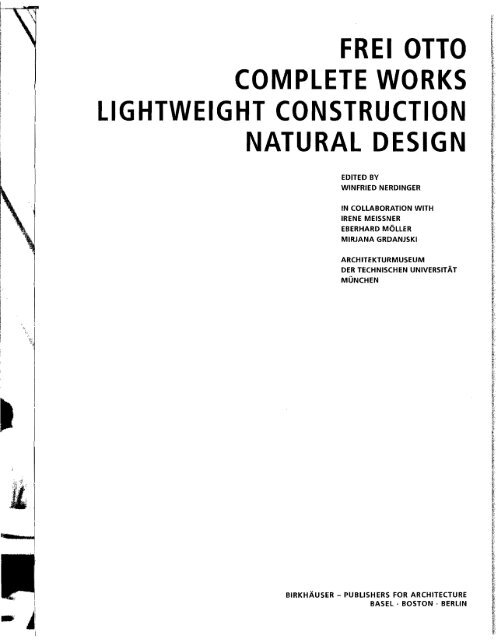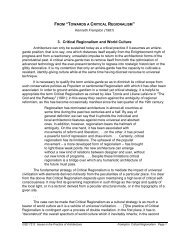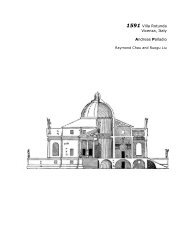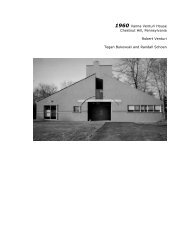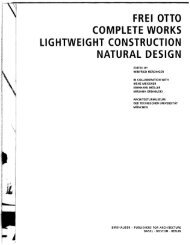frei otto complete works lightweight construction natural design
frei otto complete works lightweight construction natural design
frei otto complete works lightweight construction natural design
You also want an ePaper? Increase the reach of your titles
YUMPU automatically turns print PDFs into web optimized ePapers that Google loves.
I',','I',.,:,,:?;'"<br />
" .<br />
','<br />
-J<br />
FREI OTTO<br />
COMPLETE WORKS<br />
LIGHTWEIGHT CONSTRUCTION<br />
NATURAL DESIGN<br />
EDITED BY<br />
WINFRIED NERDINGER<br />
IN COLLABORATION WITH<br />
IRENE MEISSNER<br />
EBERHARD MOLLER<br />
MIRJANA GRDANJSKI<br />
ARCHITEKTURMUSEUM<br />
DER TECHNISCHEN UNIVERSITAT<br />
MONCHEN<br />
BIRKHAUSER - PUBLISHERS FOR ARCHITECTURE<br />
BASEL· BOSTON· BERLIN
CONTENT<br />
Foreword<br />
FrelOtto<br />
Working for a Better "Earth for Mankind"<br />
Winfried Nerdinger<br />
Natural Forms - Architectural Forms<br />
Rainer Barthel<br />
The Lightweight Principle<br />
Eberhard Moller<br />
Frel Otto and Biology<br />
Ulrich Kull<br />
In Harmony with Nature and Technology<br />
On Frei Otto'S Architecture and Work Method<br />
Irene Meissner<br />
MODELS AND EXPERIMENTS<br />
Where Architecture<br />
and Civil Engineering Meet<br />
Rainer Graefe<br />
Institute for Development of Lightweight<br />
Construction and Atelier Warmbronn<br />
Ewald Bubner<br />
The Institute for Lightweight Structures<br />
University Institute and Spinners' Centre<br />
Berthold Burkhardt<br />
Frei Otto and Ove Arup<br />
A Case of Mutual Inspiration<br />
Christian Brensing<br />
Frei Otto and Ted Happold<br />
1967-1996 and Beyond<br />
Michael Dickson<br />
Ethics, Aesthetics and Innovation<br />
A Speech by Frei Otto<br />
6<br />
8<br />
16<br />
32<br />
44<br />
56<br />
64<br />
70<br />
80<br />
90<br />
102<br />
110<br />
124<br />
WORKSHOP OF IDEAS<br />
DRAWINGS AND SKETCHES<br />
CATALOGUE OF WORKS<br />
Buildings and Projects 1951-2004<br />
Irene Meissner, Eberhard Moller<br />
Appendix<br />
Frei Otto and Projects in the Orient<br />
A Personal Account<br />
Bodo Rasch<br />
Homage to Frei Otto<br />
Biography<br />
Bibliography<br />
Contributors<br />
Glossary<br />
Index of Names<br />
Index of Locations<br />
Thanks<br />
illustration Credits<br />
130<br />
168<br />
360<br />
362<br />
368<br />
370<br />
383<br />
384<br />
386<br />
388<br />
389<br />
390
Olympic roofs, Munich, working on<br />
the measurement model<br />
ETHICS, AESTHETICS AND INNOVATION<br />
A Speech by Frei Otto<br />
There are five to ten million architects allover the world, and they speak over .<br />
a hundred languages. Five to ten thousand of them have come together in Berlin<br />
(XXI World Architecture Congress from 22 to 26 July 2002) to try to find common<br />
ground.<br />
They come from all continents, cultures, religions and societies. And they are able<br />
not only to communicate, but also to understand one another not so much<br />
through the spoken word, but through their shared conception of their work. They<br />
all have the same ethic, regardless of the colour of their skins and regardless of<br />
where they live, how they vote or how they worship. They speak with their actions:<br />
with their ideas, <strong>design</strong>s, and buildings.<br />
Doctors have their Hippocratic oath. Architects live within their own world of ethics.<br />
Architects help people to live on earth, to create houses and residences. They practise<br />
brotherly love even towards people whom they do not know. They fight for peace<br />
with the means at their disposal. They do not harm others: neither in peace nor in<br />
war, neither with their hands, weapons. <strong>works</strong> or thoughts. They respect the <strong>works</strong><br />
of others and work to preserve extraordinary examples of architecture. When they<br />
build. they are careful in their use of human strength, energy, and materials, and they<br />
strive to build in harmony with nature and to preserve nature as the basis of all life.<br />
This means that architects must be able to say no when they are asked to perform<br />
a service which they cannot support, because their work can cause harm to human<br />
beings in body and spirit, and can even kill. Saying no at the right moment and in<br />
the right place is necessary whenever a building project is harmful to nature and the<br />
environment. By saying no, we can prevent harm, though we cannot create some<br />
thing new.<br />
The architect's service to human beings and to art begins with his acceptance of<br />
the builder'S ethics and of his responsibility to future generations. The latter begins<br />
with the development of solutions for previously insoluble problems. Architects take<br />
action when they see that something is wrong - not only to avert or contain danger,<br />
but also when people have no place to sleep or when the need arises to conceive<br />
of a more beautiful living world. Architects must make it possible for the useful and<br />
the beautiful to be created together.<br />
It is said that there are five to ten million architects in the world a seemingly large<br />
number. However, when one considers the vast amount of work that needs to be<br />
done, the number does not seem too large. Architects have been around for at least<br />
ten thousand years. In essence, their tasks are still the same, but they are much more<br />
complex than they used to be. Today, the task of the architect is not simply to provide<br />
shelter from the forces of nature, but to create conditions which allow people to live<br />
in harmony with nature and at peace with one another.<br />
Human beings are not peaceful by nature. As in many animals, inhibitions against<br />
killing are usually effective only against members of the same community who are<br />
physically present. Often people may kill someone for the simple reason that the other<br />
person is dressed differently. And whole cities and countries are sometimes destroyed<br />
together with all their inhabitants, no matter how solidly their houses are built, for<br />
no better reason than that the people there speak a different language and pray to<br />
a different god, and that their houses look strange.<br />
Whether it will be possible in future to contribute to world peace by means of good<br />
residential and urban planning is something we can only hope. However, this hope<br />
is by no means a vain one, even if we still have a long way to go.<br />
For most architects, their professional ethics is something they take for granted. It is<br />
the time-honoured, traditional attitude of every builder in the world. It is the basis of<br />
125
126<br />
today's building practices and has its roots in most people's longing for security,<br />
peace, and well-being.<br />
If we ever succeed in drafting a code of global ethics which everyone in the world<br />
can identify with, we could do far worse than take the architects' code of professional<br />
ethics as a model. Such a global code could read: .. Human beings shall preserve<br />
their planet, the source of all life. They shall preserve themselves and all their fellows<br />
from damage to body, spirit, and property, and they shall help one another in need."<br />
Even if architects, urban planners, and engineers recognise a shared code of professional<br />
ethics. this does not mean that they are all above reproach. The Union internationale<br />
des architectes is not a haven of the just and unblameable. However, its<br />
perceived duty is to ensure that architects, in addition to producing buildings that<br />
give shelter and solving technical problems with technical means, are prepared to go<br />
the extra mile and produce beautiful structures that give their owners a sense of<br />
being at home.<br />
However, there are still architects who fail to fulfil this mission. We talk so much<br />
about humanity, brotherly love and the preservation of resources - but what do we<br />
see happening every day? All over the world there is a consensus of good intentions,<br />
but putting these intentions into practice is frequently fraught with disharmony.<br />
Builders sometimes become not the representatives of professional ethics, but fighters<br />
for influence and vested interests. And heated words are exchanged in arguments<br />
about trivial matters of conventional aesthetics. Suddenly, the focus is more on one's<br />
own survival than on the lives of one's fellow human beings, and little respect is<br />
paid to competitors and their <strong>works</strong>.<br />
And structures come into being which imperceptibly undermine the architect's ethos.<br />
Over the years, a new type of high-performance star architect has come into being.<br />
These people can do everything except say no; they will build everything the powerful<br />
and influential ask for; they employ hundreds of young architects, but ask them<br />
to deny their own abilities. The powerful divide up among themselves a world which<br />
really belongs to everyone; they occupy it and sell it to become more powerful still.<br />
They commission anonymous, soulless houses of which we already have far too<br />
many in too many places around the world.<br />
Ethics and aesthetics have always been regarded as cultural values which belong to<br />
all people and all societies. Ethics is based on broad consensus. In contrast, aesthetics<br />
is defined by a minority. Aesthetics is regarded as the study, and sometimes the<br />
science, of the beautiful, and it is based on those perceptions which go beyond the<br />
functional to the special and which encompass non-functional, sensory details which<br />
are difficult to explain in words. Ethics is the basis of the survival of the human race;<br />
aesthetics is a matter of education.<br />
There are no rules or schools for aesthetics. The capacity for aesthetic perception,<br />
like the more advanced ability to produce aesthetic creations, seems to be determined<br />
rather imprecisely and sporadically in the genetic code.<br />
Perceptions can vary endlessly, and they can function as a survival mechanism. Not<br />
all perceptions, however, are biologically functional. The perceptual ability of human<br />
beings goes far beyond the functional and enters the unlimited world of sensory<br />
perception. Among the billions of perceptions experienced by every individual, those<br />
related to beautiful and pleasant things occupy a special place which is usually independent<br />
of considerations of good and evil or profit and usefulness.<br />
The success of an architect's work and the manifestation of aesthetics in his work is<br />
dependent not only of the intensity with which he expresses his artistic and sensory<br />
perceptions in his work, but also on the observer of the finished building. Like other<br />
artists, architects experience their <strong>works</strong> in a special way and with all their senses,<br />
but they do so in a <strong>complete</strong>ly different way from an independent observer. Architects<br />
are biased; they see weaknesses and strengths which go unnoticed by others,<br />
and thus they stand apart from the social trends of their time.<br />
Something that is beautiful is not necessarily ethical too. Beauty is not equal to<br />
goodness. Beauty can be cruel, and ugliness can be good. And sometimes the beau
128<br />
Five to ten thousand architects from all over the world have come to Berlin, a city<br />
which was ravaged by two world wars, two unforgivable low points of history.<br />
Before World War I, Berlin was the cradle of classical modernism. This became the<br />
first world architecture movement. Even if we believe today, eight decades later, that<br />
the idea of a general world architecture has lost its meaning because every building<br />
on earth must be a special one, we must nevertheless acknowledge that every object<br />
in architecture has a global component which is related to its function, usability, and<br />
the exploitation of technologies which are increasingly becoming the same all over<br />
the world.<br />
After the end of World War II, the ruins of the cities gave birth to the idea of har<br />
mony and consensus with nature. This was the idea of the green, ecological postwar<br />
modernism. Sadly, this idea exhausted itself very quickly. After the last of the rubble<br />
was carted away, architecture once again began to be imported. And yet this "green<br />
modernism", which was formulated here in Berlin fifty years ago, had a global echo<br />
even though it resulted in only a few actual buildings, none of which resembles any<br />
other one.<br />
Our art of building has reached a turning point. Now that the fashions and experi<br />
mental styles of the past decades have faded out, I regard the architecture of the<br />
new century - in green landscapes, with individualistic houses - as a part of nature.<br />
Each building has its own unmistakable form and represents a part of a constantly<br />
changing whole in a world of peace and love.<br />
The art of architecture is free and must remain free. Therefore, the face of the true<br />
architecture of the new century is as yet unknown. I hope that it will be good;<br />
I hope that it will radiate beauty.<br />
Corrected transcription of a recording of a free speech held on July 25. 2002 at the<br />
XXI World Architecture Congress in Berlin.


